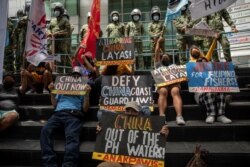Reader alert: This fact check involves some of the swirling geopolitics around the Ukraine war and the Chinese-Russian minuet that’s playing out in response. Apologies in advance for some necessary background.
On Monday, March 28, the United States and the Philippines launched their largest joint military exercise in the northern Philippines in years. The annual exercise, involving nearly 9,000 personnel, runs until April 8.
Back in 2016, Philippine President Rodrigo Duterte, then in his first year in office, threatened to scrap a U.S. defense pact that made such exercises possible. That was part of Duterte’s efforts to pivot towards China and Russia.
Next month, though, the Philippines will hold presidential elections. Duterte cannot run for another term and is set to step aside in June. And he has recently signaled wariness about China while seeking to bolster U.S. ties.
Duterte warned earlier this month that China could invade the Philippines if Russia uses nuclear weapons in its war against Ukraine. He also offered to back the United States if it gets caught up in the Ukraine conflict.
Meanwhile, as the world focuses intently on war in Europe, U.S. officials say Beijing has fully militarized three islands in the South China Sea, where China and the Philippines have competing claims.
On March 28, a journalist with Agence France-Presse asked Chinese Foreign Ministry spokesman Wang Wenbin about the Philippine-U.S. war games and a recent encounter between Philippine and Chinese coast guard vessels.
The Philippines accused Chinese coast guard ships of conducting dangerous maneuvers close to Philippine coast guard vessels near Scarborough Shoal, known as Huangyan Dao in China.
Wang responded:
“Huangyan Dao is China’s inherent territory. China has sovereignty over Huangyan Dao and its adjacent waters as well as sovereign rights and jurisdiction over relevant waters. We hope that the Philippine ships will earnestly respect China’s sovereignty and rights and interests, abide by China’s domestic law and international law, and avoid interfering with the patrol and law enforcement of the China Coast Guard in the above-mentioned waters.”
That, in sum, is false.
In fact, the issue of Scarborough Shoal’s sovereignty remains legally unresolved. And an international tribunal has rebuked Beijing for making sweeping claims to the South China Sea and denying the Philippines its fishing rights near the shoal.
China seized Scarborough Shoal, some 137 miles east of the Philippines’ island of Luzon, in 2012. The island is 370 miles southeast of China.
In January 2013, the Philippines brought a legal case against China under the United Nations Convention on the Law of the Sea (UNCLOS) over its sweeping maritime claims in the South China Sea.
In 2016, an international tribunal in The Hague appointed to handle the case rebuked many of China’s claims. But the tribunal explicitly said it was “not deciding sovereignty over Scarborough Shoal,” leaving the claims undecided.
Notably, though, the court did find that both China and the Philippines have “traditional fishing rights” at the shoal, and that “China had violated its duty to respect to the traditional fishing rights of Philippine fishermen by halting access to the Shoal after May 2012.”
While Wang did not specify over which “adjacent waters” or “relevant waters” China has sovereignty, the tribunal rebuked Beijing for attempting to assert its claims within the “nine-dash line.” That line is an arbitrary boundary that Beijing imposed in a bid to assert control over most of the South China Sea.
The Hague tribunal found that China’s claims to the bulk of the South China Sea violated the Philippines' rights to its Exclusive Economic Zone (EEZ) and territorial waters.
The U.N. Convention on the Law of the Sea recognizes the 200-nautical mile stretch of sea from the coast of a state as its EEZ. Territorial waters extend 12 miles from the baseline (the low water mark along a coast) of a coastal state.
Article 19 of UNCLOS allows foreign ships, including military vessels, to pass through the territorial waters of another state so long as that passage is “not prejudicial to the peace, good order or security of the coastal state.”
China’s strategy of dominance in the South China Sea involves claiming islands, shoals, rocks and other formations. It then draws baselines around those land formations and asserts sovereignty over all the surrounding waters.
Polygraph.info has previously examined in depth why this strategy does not hold water under international maritime law.
The Hague Tribunal covered the status of Scarborough Shoal and its connecting waters.
China, which refused to take part in the arbitration, claims Scarborough Shoal is an island. Under UNCLOS, islands have the same maritime zones as other landmasses, including a territorial sea, contiguous zone, EEZ and continental shelf.
The Philippines contended that Scarborough Shoal was a rock.
Commenting on the tribunal’s findings, the Asia Maritime Transparency Initiative (AMIS) wrote that “neither Scarborough Shoal nor any of the high-tide features in the Spratly Islands ‘are capable of sustaining human habitation or an economic life of their own’ and ‘are therefore legally rocks for purposes of Article 121(3) and do not generate entitlements to an exclusive economic zone or continental shelf.’”
“This means that the only EEZs and continental shelves in the South China Sea are those generated by the coastlines of the surrounding states and, possibly, some of the Paracel Islands,” AMIS said.
Since Scarborough Shoal was found to be a rock above water at high tide, it is entitled to a territorial sea. Scarborough Shoal is also well within the Philippines’ EEZ.
Still, as previously mentioned, The Hague tribunal recognized both sides’ traditional fishing rights at the shoal.
The Philippines Coast Guard recently confirmed “the increasing presence of Filipino fishermen” near Scarborough Shoal, which they said demonstrated “intensified efforts to safeguard Filipino fishermen.”
China never accepted The Hague tribunal’s ruling, and has become increasingly assertive in the South China Sea in recent years.







